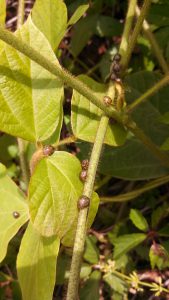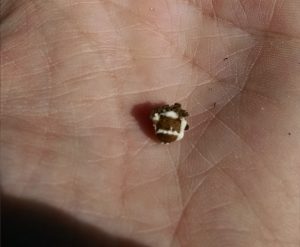A few years ago, Florida is extended a warm welcome to a new pest – The Kudzu Bug! The kudzu bug was first documented in the US in 2009 in Northeast Georgia. It has quickly spread throughout the southeast.
At first, a pest that attacks kudzu sounds pretty good but this bug also attacks wisteria, figs, and other legumes like beans and peas. It is a serious pest to soybeans that are grown in our area. They are similar to stink bugs and discharge an odor when disturbed. Skin and eye irritation can occur from this odor emission.
Kudzu bugs are small (3.5-6mm long), and are rounded oblong in shape, and olive-green in color. They lay egg masses in two rows of 13 to 137 eggs per row. The first generation of kudzu bugs seem to prefer to feed on kudzu but subsequent generations will feed on and lay eggs on other legumes. When fall comes, the adults over-winter where they can find shelter. They crawl under tree bark and into cracks in houses.
If kudzu bugs make their way into your home, you can vacuum them up and dispose of them. If they are in your landscape or garden, you can set up a trap using a bucket of soapy water and a piece of white poster board. Kudzu bugs are attracted to lighter colors. To make the trap, cut the poster board in half. Attach the two halves by cutting a line up the middle of the two pieces and inserting them into each other. They should be in the shape of a plus sign. Place the board over the bucket of soapy water. As the insects hit the board, they will fall into the soapy water and drown.
Insecticides can be used but timing and placement are very important. Right now, kudzu bugs are just becoming active making now a good time to spray kudzu host plants with an insecticide. Insecticide with active ingredients ending in “-thrin”, such as pyrethrin, cyfluthrin, etc., are effective against kudzu bugs. Always read and follow label directions and precautions when using any pesticide. Controlling kudzu near your house will help decrease the number of bugs, but they are strong flyers and can migrate through neighborhoods that aren’t near kudzu.
There are some natural enemies of kudzu bugs! Generalist predators like green lacewings, lady beetles, damsel bugs and big eye bugs will attack kudzu bug nymphs. There are also two parasitoids that attack them. Both discovered in 2013, there is a tiny wasp that develops in the kudzu bug eggs and a fly that lays its eggs in the adult kudzu bug. The Kudzu bug, like other exotic invasive insect, are opportunistic and we have yet to see how many different plants species may serve as a host for this pest. Beauveria bassiana has also been found to infect kudzu bugs and seem to be an effective natural enemy.
For more information on the kudzu bug, contact the UF/IFAS Extension Office in your county.
- Common Wildlife Food Plot Mistakes - November 8, 2024
- Seasonality of Prescribed Burning Workshop - February 23, 2024
- Preserving Wild Game Meat - January 26, 2024


